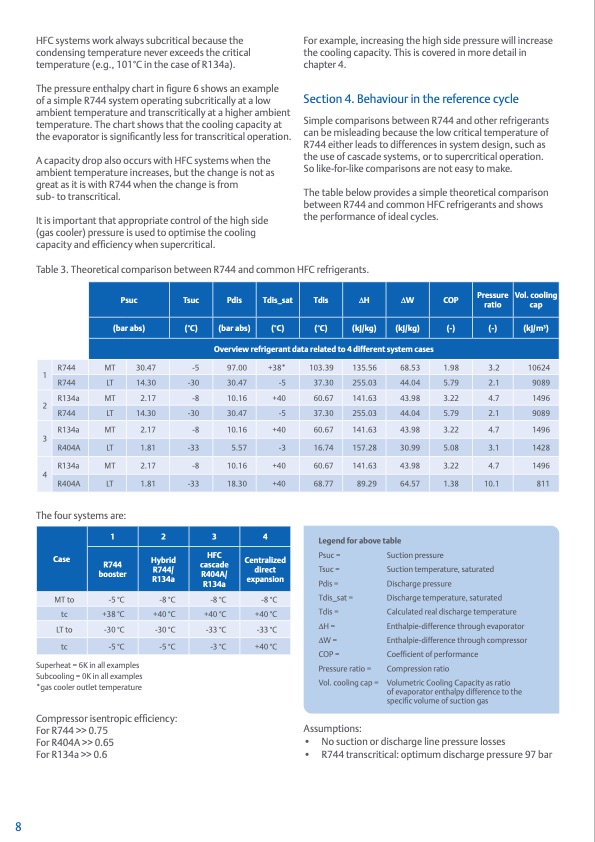
PDF Publication Title:
Text from PDF Page: 008
HFC systems work always subcritical because the condensing temperature never exceeds the critical temperature (e.g., 101°C in the case of R134a). The pressure enthalpy chart in figure 6 shows an example of a simple R744 system operating subcritically at a low ambient temperature and transcritically at a higher ambient temperature. The chart shows that the cooling capacity at the evaporator is significantly less for transcritical operation. A capacity drop also occurs with HFC systems when the ambient temperature increases, but the change is not as great as it is with R744 when the change is from sub- to transcritical. It is important that appropriate control of the high side (gas cooler) pressure is used to optimise the cooling capacity and efficiency when supercritical. For example, increasing the high side pressure will increase the cooling capacity. This is covered in more detail in chapter 4. Section 4. Behaviour in the reference cycle Simple comparisons between R744 and other refrigerants can be misleading because the low critical temperature of R744 either leads to differences in system design, such as the use of cascade systems, or to supercritical operation. So like-for-like comparisons are not easy to make. The table below provides a simple theoretical comparison between R744 and common HFC refrigerants and shows the performance of ideal cycles. Table 3. Theoretical comparison between R744 and common HFC refrigerants. Psuc Tsuc Pdis Tdis_sat Tdis ΔH ΔW COP Pressure ratio Vol. cooling cap (bar abs) (°C) (bar abs) (°C) (°C) (kJ/kg) (kJ/kg) (-) (-) (kJ/m3) Overview refrigerant data related to 4 different system cases 1 R744 MT 30.47 -5 97.00 +38* 103.39 135.56 68.53 1.98 3.2 10624 R744 LT 14.30 -30 30.47 -5 37.30 255.03 44.04 5.79 2.1 9089 2 R134a MT 2.17 -8 10.16 +40 60.67 141.63 43.98 3.22 4.7 1496 R744 LT 14.30 -30 30.47 -5 37.30 255.03 44.04 5.79 2.1 9089 3 R134a MT 2.17 -8 10.16 +40 60.67 141.63 43.98 3.22 4.7 1496 R404A LT 1.81 -33 5.57 -3 16.74 157.28 30.99 5.08 3.1 1428 4 R134a MT 2.17 -8 10.16 +40 60.67 141.63 43.98 3.22 4.7 1496 R404A LT 1.81 -33 18.30 +40 68.77 89.29 64.57 1.38 10.1 811 The four systems are: Case 1 2 3 4 R744 booster Hybrid R744/ R134a HFC cascade R404A/ R134a Centralized direct expansion MT to -5 °C -8 °C -8 °C -8 °C tc +38 °C +40 °C +40 °C +40 °C LTto -30 °C -30 °C -33 °C -33 °C tc -5 °C -5 °C -3 °C +40 °C Legend for above table 8 Superheat = 6K in all examples Subcooling = 0K in all examples *gas cooler outlet temperature Compressor isentropic efficiency: For R744 >> 0.75 For R404A >> 0.65 For R134a >> 0.6 Psuc = Tsuc = Pdis = Tdis_sat = Tdis = ΔH = ΔW = COP = Pressure ratio = Vol. cooling cap = Suction pressure Suction temperature, saturated Discharge pressure Discharge temperature, saturated Calculated real discharge temperature Enthalpie-difference through evaporator Enthalpie-difference through compressor Coefficient of performance Compression ratio Volumetric Cooling Capacity as ratio of evaporator enthalpy difference to the specific volume of suction gas Assumptions: • No suction or discharge line pressure losses • R744 transcritical: optimum discharge pressure 97 barPDF Image | CO2 Product Guide 2021

PDF Search Title:
CO2 Product Guide 2021Original File Name Searched:
2021-co2-refrigeration-4217772.pdfDIY PDF Search: Google It | Yahoo | Bing
CO2 Organic Rankine Cycle Experimenter Platform The supercritical CO2 phase change system is both a heat pump and organic rankine cycle which can be used for those purposes and as a supercritical extractor for advanced subcritical and supercritical extraction technology. Uses include producing nanoparticles, precious metal CO2 extraction, lithium battery recycling, and other applications... More Info
Heat Pumps CO2 ORC Heat Pump System Platform More Info
| CONTACT TEL: 608-238-6001 Email: greg@infinityturbine.com | RSS | AMP |